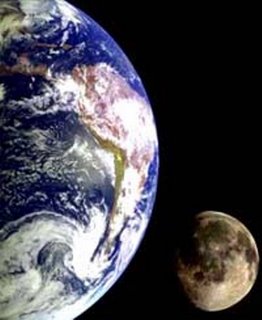Moon Pact

Russia and China could sign Moon exploration pact this year, says the head of the Russian Space Agency
Moscow (RIAN) Sep 12, 2006
China has already successfully launched into orbit two manned space vehicles. Its first manned flight three years ago made it the third country to launch a human being into space on its own, after Russia and the U.S. "I can say that as a result of the Russian-Chinese space sub-commission's work, our priority is a joint program on Moon exploration," Anatoly Perminov said. "A number of contracts have been signed involving both Russian and Chinese enterprises."
Original text from Space Daily
More on the Lunar Age @ Moon Daily
_______________________________________________________
Solar Energy: Charged For The Future
Once regarded as costly and impractical, solar technology is now poised to play a larger role in the future, thanks to new developments that could result in lower costs and improved efficiency. Potential applications include cell phones, computers, automobiles, homes and office buildings.
The American Chemical Society will addressed the progress and challenge of this technology during a first of its kind symposium, "Science and Technology of Next Generation Photovoltaics," from Sunday, Sept. 10, through Tuesday, Sept. 12, in San Francisco during the Society's 232nd national meeting.
Here are a few highlights of research toward improving the efficiency of solar cells:
"Plastic" solar cells show gains in performance.
Nobel Prize winner Alan J. Heeger, Ph.D., and colleagues at the University of California, Santa Barbara, say that new developments in "plastic" solar cells, particularly chemical modifications to titanium oxide layers, could provide efficiencies of up to 15 percent in the future. He already has developed plastic solar cells with efficiencies between 5 percent and 6 percent, considered among the highest to date for this type of solar cell. These developments could pave the way for wider use of plastic solar cells, a type of conducting polymer, which are increasingly seen as a low cost, efficient and long-lasting source of solar energy. Heeger, a professor at the University, shared the 2000 Nobel Prize in Chemistry for his contributions toward the discovery of plastics that conduct electricity. His presentation will be delivered by study co-author and University colleague Kwanghee Lee, Ph.D.
Ultrathin, dye-sensitized solar cells called most efficient to date.
Researchers in Switzerland have developed dye-sensitized solar cells that have reached the highest efficiencies to date among a new generation of thin film photovoltaic devices that show promise as a low-cost energy source. The new cells, composed of an ultrathin film of nano-sized semiconductor crystals such as titanium dioxide, have been shown in laboratory studies to produce efficiencies of 11 percent, whereas most new solar cells have efficiencies between 4 percent and 5 percent, according to Michael Graetzel, Ph.D., a chemist at the Swiss Federal Institute of Technology, Lausanne. These cells, which can be engineered into inexpensive, flexible sheets, could be used as coatings on glass windows to supply electric power to homes and businesses or as coatings on tents to supply power for soldiers in the field. The cells could be used in consumer applications within two to three years, the researcher says.

_______________________________________________________
Carbon nanotubes from wikipedia Enlarge Image
Carbon nanotubes could boost efficiency of solar cells --
Researchers at the University of Notre Dame in Indiana say they have found a new and promising way to boost the efficiency of solar cells. In preliminary studies, carbon nanotubes that were engineered into the architecture of semiconductor solar cells (composed of cadmium sulfide, zinc oxide and titanium dioxide) resulted in a doubling of the cells' photoconversion efficiencies (converting light into energy). In some cases, the efficiency of solar cells jumped from 5 percent to 10 percent in the presence of carbon nanotubes, according to Prashant Kamat, Ph.D., a professor of chemistry at the University. Carbon nanotubes also could be added to other types of solar cells, such as dye-sensitized solar cells and organic solar cells based on conducting polymers, to create similar or even stronger efficiency boosts, he says.
The American Chemical Society --
the world's largest scientific society, is a nonprofit organization chartered by the U.S. Congress and a global leader in providing access to chemistry-related research through its multiple databases, peer-reviewed journals and scientific conferences. Its main offices are in Washington, D.C., and Columbus, Ohio.
Original text from Science Daily releases 11th September 2006
Carbon atoms in graphite form honeycomb structure, read on:
Pencils Blackholes and the Klein Paradox by Stefan @ Backreaction
_______________________________________________________
Famous Quotes:
"The beginning is always today." Mary Wollstonecraft
Ancient Wisdom: "Today is the first day, of the rest of your life" Q9
_______________________________________________________


<< Home